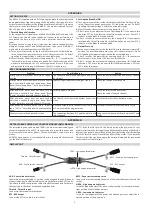
30
Section 05
Flying the MIURA RS
Turns
With the MIURA RS, SWING has
developed a glider which reacts
immediately to steering input and is
extremely responsive. The MIURA RS
performs best in turns when it is flown
with sufficient speed and weight-
shifting. Too much braking increases
the sink rate.
The MIURA RS has very low negative
tendency. If the pilot shifts his weight
clearly to the braked side, the control
travels are long and the glider turns
tightly and accurately. So it can also be
turned in a tight area by carefully
pulling the inside brake line.
If the brakes are applied more, the
bank attitude increases and the glider
will fly a fast turn increasing in
steepness, which will eventually
become a spiral dive (further
information on this is in the section
“
Spiral Dive
”
).
TIP
The general principle when turning
is first to use weight-shifting and
then to apply the brakes. The
advantages of this are:
•
longer control travel
•
more direct handling
•
less sink in turns
Emergency steering
If for some reason the brake lines are
not working, e.g. if the knot on the
brake handle has come undone or a
brake line is defective, the MIURA RS
can also be steered and landed using
the back risers.
In this case, stall happens more quickly
and the pilot must compensate for the
changed flight behaviour by pulling
carefully on the risers.
You will find further information about
steering with back risers in section “C
-
bridge system”
Rapid descent methods
Many flying situations call for a very
rapid descent to avoid a dangerous
situation, e.g. the upcurrent from a
cumulus cloud, an approaching cold
front or a storm front.
Rapid descent methods should all be
practised in calm conditions and at
sufficient altitude so that a pilot is then
able to employ them effectively if
extreme conditions arise. The rapid
descents are divided into three
different manoeuvres which increase
the sink rate in a safe and controllable
manner.
WARNING
Any rapid descent methods other
than those described in this section
have not been tested by SWING.
SWING advises against using any
rapid descent methods other than
those described in this section. In an
extreme situation, they could result
in uncontrollable flight positions.
Spiral dives
The spiral dive is the most effective
method for making a rapid descent,
and can allow sink rates of up to 20m/s
to be reached. It is suitable where there
is a high ascent rate and little wind.
During testing, the MIURA RS always
recovered automatically from spiral
dives when t
he pilot’s position was
neutral. It may continue to turn over
several rotations.
The length of time it continues to turn
depends on sink rate and harness
geometry and adjustment.
















































